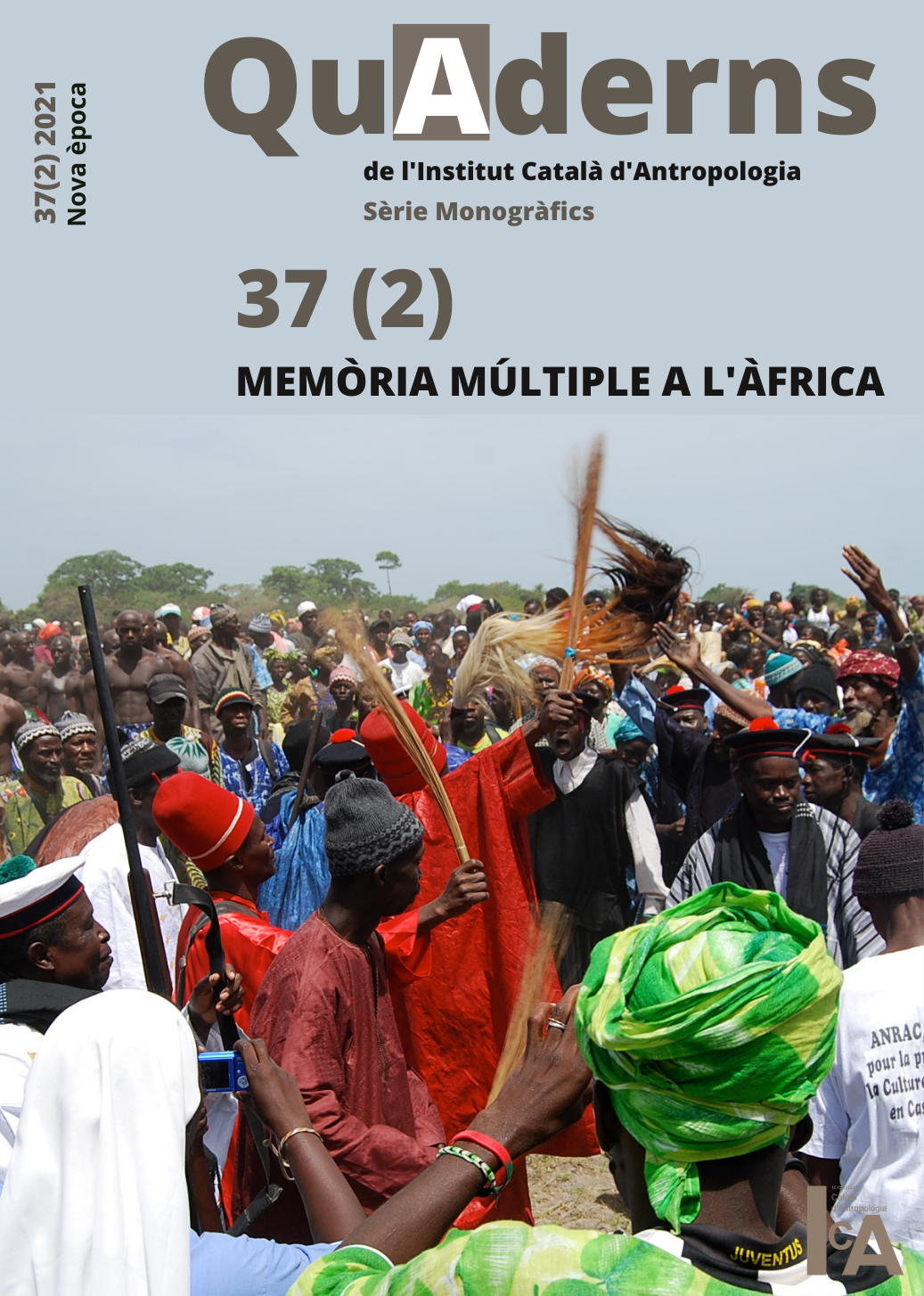The forgotten Shaykh? Memories of a jihād in the ṭarīqa Tijāniyya
DOI:
https://doi.org/10.56247/qua.368Keywords:
memory, jihad, Islam, West Africa, colonialism, TijaniyyaAbstract
‘Umar Al-Fūtī Tāl was the second great name of the Tijāniyya after its founder Aḥmad Tijāni (1735-1815). He was responsible for the thorough argumentation and justification of its doctrines in the Islamic scholarly tradition, as well as for the expansion and popularization of the ṭarīqa on the West African side. In Al-Fūtī converge not only intellectuality or spirituality but ethnicity and power. And even certain messianic attributes that his immediate disciples and of the justly later generation bestowed upon him. The aim of this article, within the context of the monograph, is to analyze how the conflict and post-conflict of Al-Fūtī's jihād impacted on the different memories until fading his figure, his work, and his logics in Islamic intellectual history and specifically in the memory of the Tijāniyya itself.
Downloads
Global Statistics ℹ️
|
430
Views
|
250
Downloads
|
|
680
Total
|
|
References
Al-Fūtī, U. (1964). Kitāb Rimaḥ. Dār al-kutub al-Ilmiyah.
Al-Fūtī, U. (1980). “‘Umar Fūtī Tāl, Tadhkirat al-mustarshidīn wa falā ḥājj al- ṭālibīn” Bulletin de l’Institut Fondamental d’Afrique Noir, ed. y tr. Claudine Gerresch-Dekais, n. 42, pp. 524-553.
Assmann, J. (2000). Religion und kulturelles Gedächtnis. Zehn Studien. Beck.
Benjamin, W. (1973). Tesis de Filosofía de la Historia. Taurus.
Binger, L.G. (1906). Le Peril de l’Islam. Comité de l’Afrique française.
Chatelier, A. (1899). L’Islam en L’Afrique Occidentale. Steinheil Editeur.
De Diego González, A. (2017). “Los huérfanos del jihād. Jihād, estrategias de identidad y transformación hacia la no violencia en la ṭarīqa Tijāniyya en Senegal” Estudios de Asia y África, nº2 (163), pp. 317-348. http://dx.doi.org/10.24201/eaa.v52i2.2216 DOI: https://doi.org/10.24201/eaa.v52i2.2216
De Diego González, A. (2018). “Entre la hagiografía y la historiografía. Un análisis de la figura y la doctrina de shaykh Aḥmad Tijāni” Anaquel de Estudios Árabes, nº 29, pp. 63-88. https://doi.org/10.5209/ANQE.58713 DOI: https://doi.org/10.5209/ANQE.58713
De Diego González, A. (2019a). Sufismo Negro. Una breve introducción al sufismo de África Occidental. Almuzara.
De Diego González, A. (2019b). “El juego geopolítico de Marruecos y Arabia Saudí en África Occidental” Araucaria. Revista Iberoamericana de Filosofía, Política, Humanidades y Relaciones Internacionales, nº 21, 41, pp. 415-438. https://doi.org/10.12795/araucaria. 2019.i41.20 DOI: https://doi.org/10.12795/araucaria.2019.i41.20
De Diego González, A. (2020a). Populismo Islámico. Almuzara.
De Diego González, A. (2020b). Ley y Gnosis. Historia intelectual de la Ṭarīqa Tijāniyya. Editorial Universidad de Granada.
Falola, T. (2009). Colonialism and Violence in Nigeria. Indiana University Press.
Halbwachs, M. (1992). On Collective Memory. Ed. Lewis A. Coser. The Chicago University Press. DOI: https://doi.org/10.7208/chicago/9780226774497.001.0001
Hanif, M. A. (2018). Debating Sufism: The Tijāniyya and its opponents. Tesis doctoral.
Bayreuth: Universität Bayreuth. https://epub.uni-bayreuth.de/4413/1/PhDthesis.pdf
Kane, O. (2016). Beyond Timbuktu: An Intellectual History of Muslim West Africa, Cambridge: Harvard University Press. https://doi.org/10.4159/9780674969377 DOI: https://doi.org/10.4159/9780674969377
Kassim, A. y Zenn, J. (2017). “Justifying War: The Salafi-Jihadi Appropriation of Sufi Jihad in the Sahel-Sahara” Current Trends in Islamist Ideology, nº 21, 86-114.
Maanan, A. M. (2006). Tasawwuf. Introducción al Sufismo. Almuzara.
Marty, P (1917). Études sur l’Islam au Senegal. E. Leroux.
Marty, P (1920). Études sur l’Islam et les tribes du Soudan. E. Leroux. DOI: https://doi.org/10.5479/sil.212138.39088000129247
Gadamer, H-G. (2006). Verdad y método. Sígueme.
O’ Fahey, R. S. & Radtke, B. (1993). “Neo-sufism Reconsidered”, Der Islam. vol. 70, 52-87. DOI: https://doi.org/10.1515/islm.1993.70.1.52
Panikkar, R. (2001). Ecosofia: La nuova saggezza per una spiritualità della terra. Citadella editrice.
Radtke, B. (1995). “Von Iran nach Westafrika - Zwei Quellen fur al-Hâjj `Umars ‘kitâb Rimâh hizb ar-Rahim’: Zaynaddin al-Khwâfi und Shamsaddin al-Madyanî” Die Welt des Islam, 35, 1, pp. 37-69. DOI: https://doi.org/10.1163/1570060952598030
Reyes Mate, M. (2006). Medianoche en la historia: comentarios a las tesis de Walter Benjamin “Sobre el concepto de historia”. Trotta.
Reyes Mate, M. (2008). La herencia del olvido, Errata Naturæ.
Robinson, D. (1985). The Holy War of Umar Tal: The Western Sudan in the mid-nineteenth century. Clarendon Press.
Roy, O. (2017). Jihad and Death. Oxford University Press.
Sabatier, A. (1925). Le Senegal: Sa conquête et son organisation. Imp. du Gouvernement.
Sy, M. (1915). Diwān al-Shaykh Mālik Sy. s.d.
Songy, L. (1905). La France d’Afrique: Au Senegal. Librarie de’Education Nationale.
Wise, C. (ed) (2008) The Chronicles of Al Hajj Umar Tall. Disponible en línea en: http://myweb.facstaff.wwu.edu/wisec/umariantidjaniya/chronicles.html
Downloads
Published
How to Cite
Issue
Section
License
Distributed under the terms of the Creative Commons Attribution 4.0 International Use and Distribution License (CC BY-NC-SA 4.0)




